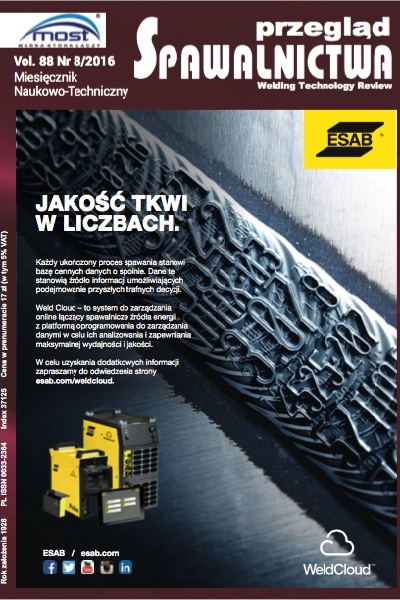Własności napoin na narzędziach rolniczych
Main Article Content
Abstract
Przedmiotem badań były napawane ostrza narzędzi maszyn rolniczych do uprawy gleby. W metodzie napawania płomieniowego użyto proszku stopowego na osnowie niklu w mieszaninie z różną zawartością proszku węglika wolframu. Badania polegały na wykonaniu pomiarów twardości, makro i mikrostruktury, analizy chemicznej napoiny i podłoża. W wyniku przeprowadzonych badań stwierdzono, że podczas napawania zachodzi częściowe rozpuszczanie się ziaren węglika wolframu w osnowie, co powoduje wzrost twardości warstwy. Ponadto, nie stwierdzono niekorzystnych zmian obniżenia twardości w stali w wyniku oddziaływania ciepła napawania. Twardość stali przed napawaniem wynosiła 36 HRC, a w strefie SWC 38-56 HRC. Badania metalograficzne ujawniły, że materiał proszku do napawania bardzo dobrze zwilża powierzchnie stali bez jej nadtopienia, w wyniku czego tworzy się z podłożem wyraźnie widoczna strefa dyfuzji.
The properties of welds on agricultural implements
Abstract
The subject of the study were surfaced blade tools of agricultural machinery for soil preparation. In the flame surfacing method was used alloy powder matrix of nickel in a mixture with different contents of tungsten carbide powder. The research involved making a measurement of hard- ness, macro and microstructure, chemical analysis of the deposit and the substrate. The results showed that while surfacing, partial dissolution of tungsten carbide grains in the matrix, which increases the hardness of the layer. In addition, no adverse changes to reduce the hardness of the steel by the heat surfacing. The hardness of the steel before hardfa- cing was 36 HRC, while in the zone SWC 38-56 HRC. Metallographic examination revealed that the powder during surfacing well wets the surfaces without melting the steel, thereby forming a substrate diffusion zone clearly visible.
Downloads
Article Details
Creative Commons CC BY 4.0 https://creativecommons.org/licenses/by/4.0/
Welding Technology Review (WTR) articles are published open access under a CC BY licence (Creative Commons Attribution 4.0 International licence). The CC BY licence is the most open licence available and considered the industry 'gold standard' for open access; it is also preferred by many funders. This licence allows readers to copy and redistribute the material in any medium or format, and to alter, transform, or build upon the material, including for commercial use, providing the original author is credited.
References
Bartkowski D., A. Młynarczak, M. Gościański, The effect of diffusion boriding on durability of the agricultural tools used in the soil. Archiwum Technologii Maszyn i Automatyzacji, 2012, Vol. 32, nr 4.
Rybacki P., Wzmocnić lemiesz i redlicę. http://agrotechnika.pl/archiwa/ wzmocnic-lemiesz-i-redlice/. 2015-08-26.
Rybacki P., Redlice i lemiesze. Czterokrotnie trwalsze po napawaniu. http://www.agropolska.pl/technika-rolnicza/transport/redlice-i- lemiesze-czterokrotnie-trwalsze-po-napawaniu,16,3.html 2015-08-26.
Selech J., M. Paczkowska, G. Kinal, B. Baran, W. Chruscinski, The comparison of effects of thermal spraying eutalloy 10112 and laser alloying with silicon nitride of cast iron outmost Disk Coulter. Journal of Research and Applications in Agricultural Engineering 2015, Vol. 60(1)
Dudziak B., M. Gościański. Wpływ wybranych parametrów laserowego napawania proszku stopów metali na stal typu c45 w aspekcie zmian twardości napoiny. Journal of Research and Applications in Agricultural Engineering. 2012, Vol. 57(1).
Dudziński W., Ł. Konat, G. Pękalski. Structural and strength characteristics of wear-resistant martensitic steels. Archives of Foundry Engineering. 2008, V o l . 8 (2) pp. 2 1 - 26.
Kostencki P., B. Łętkowska, R. Nowowiejski. Polowe badania odporności na zużycie ścierne lemieszy płużnych wykonanych ze stali z dodatkiem boru. Tribologia, 2013, nr 3. s. 49-79.
Zdravecká E., TkáÄová J., OndÃ¡Ä M., Effect of microstructure factors on abrasion resistance of highstrength steels. Res. Agr. Eng., 2014, Vol. 60, s. 115120.
Adamiak M., J. Górka, T. Kik. Comparison of abrasion resistance of selected constructional materials. Journal of Achievements in Materials and Manufacturing Engineering. 2009, Vol. 37 (2). pp. 375-380.
Dorota KAPCIŃSKA-POPOWSKA. Porównawcze badania zużycia ściernego nowej generacji stali hardox 500 i materiałów powszechnie stosowanych. Journal of Research and Applications in Agricultural Engineering 2011, Vol. 56(1).
Frydman, S. , Łętkowska, B. Odporność na kruche pękanie współczesnych stali niskowęglowych z borem. Górnictwo Odkrywkowe. 2011 | R. 52, nr 3-4 | 17-24.
http://automatykaonline.pl/. 2015-10-07. [13]
http://www.agroselnet.pl/. 2015-10-07.
